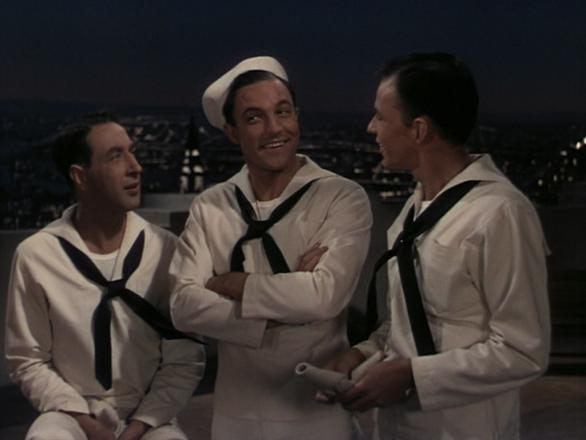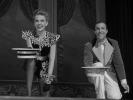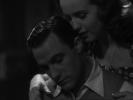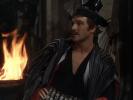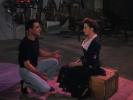Reviews
Gene Kelly and Stanley Donen
USA, 1949
Credits
Review by Victoria Large
Posted on 23 August 2012
Source Warner Bros. DVD
Categories Gene Kelly
I have this suspicion that if - perish the thought - Singin’ in the Rain had never been completed, the 1949 sailors-on-leave musical On the Town would probably be many people’s favorite Gene Kelly film. On the Town provided Kelly and longtime assistant Stanley Donen with their joint directorial debut three years before they co-helmed Singin’ in the Rain, and they’re already on the top of their game here. (It doesn’t hurt that masterful screenwriters Betty Comden and Adolph Green penned both, with On the Town being an adaption of their own musical play.) To top it all off, On the Town sports one of the most impressive ensemble casts of any musical of its era: Kelly is joined by Frank Sinatra and Jules Munshin as his fellow sailors, and their love interests are played by some of the most likable and underrated women of MGM’s storied Freed unit: Vera-Ellen, Ann Miller, and Betty Garrett. The result is a high-spirited and remarkably fast-paced musical, the kind that might even appeal to those who typically shy away from the genre.
The opening scene is iconic: three sailors of varying heights, with bright white uniforms and equally bright smiles, pile out of their ship and proceed to romp around the city singing “New York, New York” (“It’s a wonderful town/The Bronx is up and the Battery’s down”). It’s a great sequence that’s of historical interest because it incorporates some actual location shooting (virtually unheard of for a musical at that point in time). It also has an appealing innocence: the sailors scamper around famous landmarks with childlike enthusiasm rather than engaging in the seedy activities that would doubtlessly have been available to them in New York City. (Nearly forty years later, John Hughes’ Ferris Bueller’s Day Off would offer a similarly wholesome take on urban adventure.)
The guys do end up becoming preoccupied with girls, though. Kelly’s character Gabey - who is basically a sweeter and more naïve version of his Joe Brady from Anchors Aweigh - becomes infatuated with Ivy Smith, a New Yorker who has earned the mostly meaningless (but impressive to Gabey, who grew up in rural Indiana) title of “Miss Turnstiles.” Gabey is amusingly star-struck when he chances to run into Ivy shortly after stealing her poster from the subway, and following their fleeting encounter he vows to find her again, recruiting his friends to help. That’s mostly it for the plot, but On the Town, which has a fairly lean 98-minute running time, is so focused and funny that the slight plot doesn’t make a difference. The film gleefully owns its frivolity, practically daring you not to smile at its puns, double entendres, and bouncy song-and-dance routines.
All of the performers get a chance to shine, but - and this is frequently not the case with MGM musicals, even good ones - almost all of the numbers serve to advance character relationships and plot. For example, Sinatra doesn’t get any slow, wistful solo ballads in this film (he had three, and a lullaby, in Anchors Aweigh), but even Sinatra aficionados will scarcely notice that, because everything else that’s happening is so amusing and Sinatra himself is so likable throughout. He has fantastic chemistry with the gifted Betty Garrett, who plays the lady cab driver in hot pursuit of his girl-shy sailor Chip, and he also proves he’s a better comic actor than he’s received credit for. He’s especially good in his two duets with Garrett, “Come Up to My Place” and “You’re Awful.” (Folks who like Sinatra and Garrett here might want to check them out in the flawed-but-enjoyable Take Me Out to the Ball Game, which was released the same year.)
Elsewhere in the cast, Ann Miller enjoys one of the best roles of her career as Claire Huddesen, an anthropologist who the boys run into at a natural history museum. When we meet Claire she is trying - and failing - to take a more scientific and less lascivious approach to men. It’s worth noting that one of the wonderful and surprisingly modern things about On the Town is that its women are just as ardent as its men (and oftentimes more so), and that the film treats this as a fun reversal. This is especially true in the case of Claire, who dramatically dips and kisses Ozzie, the sailor played by Jules Munshin, within a few moments of their first encounter.
Now, I will grant that “Prehistoric Man,” the pun-laden song and dance that finds Claire elaborating on her fascination with the more rugged men of the past, has some offensive qualities. A friend of mine who actually has studied anthropology articulated it better than I could: when Miller and company romp around the museum singing about primitive man while mistreating cultural artifacts, they’re basically equating indigenous cultures with prehistory, which, by modern standards, is pretty culturally tone-deaf.
But then again, the same anthropologist friend also allows that holding a movie from 1949 to modern standards of sensitivity isn’t really fair—and that “Prehistoric Man” happens to be an incredibly smoking dance number. Grinning robustly, Miller whirls and taps with such rapid-fire finesse that it makes your head spin. In the last ninety seconds or so of the number, her castmates simply surround her, worshipfully waving their hands, and it feels like the only logical action they could have taken in this situation.
Indeed, though Kelly is not always thought of as a performer who was willing to share the spotlight (cue all the jokes about him using special effects to be his own dance partner in Cover Girl), there’s a real generosity of spirit to this film, the first that credited him as a director. One senses that Kelly - whose perfectionism behind the scenes remains somewhat notorious - understood the rigors of performing enough to appreciate other gifted performers when they crossed his path. At least, whenever I see “Prehistoric Man,” I like to think he looks pretty happy to be Ann Miller’s chorus boy, watching her and throwing up his hands in exultation.
Kelly does get his own showcase, however, during the film’s “Day in New York” ballet sequence, which takes its cues from Agnes de Mille’s dream ballet in the original Broadway production of Oklahoma! in 1943. In On the Town’s dream ballet, the only holdovers from the film’s main cast are Kelly and the versatile Vera-Ellen; the other dancers were brought in specifically to meet the challenges of this particular sequence. (Trainspotters take note: one of the ringers who appears in this portion of the film is Carol Haney, an assistant of Kelly’s who went on to become a well-respected Broadway performer and choreographer in her own right.) The dream ballet is marked by the athleticism that defined much of Kelly’s work as a dancer and choreographer, and it also represents his keen interest in storytelling through dance, as well as his investment in bringing ballet into the popular consciousness.
Beyond that, the sequence is quite lovely, particularly during a short but memorable pas-de-deux between Kelly and Vera-Ellen that finds the two dancers standing in a single spotlight while their shadows play against a vivid red wall. They coquettishly move around a ballet barre, almost-but-not-quite touching until she briefly wraps an arm around his neck. They then dance a little longer before she wraps her arms around him once more, and he gently twirls both of them to the floor. It’s hauntingly sensual—perhaps the one moment where On the Town shifts from being playfully lusty to seriously sexy. Though some viewers today think of MGM musicals as being chipper and quaint, Kelly knew that dance could speak to otherwise-submerged desires, and that’s what it does here, in a segment that actually reads as a dream-within-a-dream.
That On the Town is able to sneak a sensuous bit of ballet between gags about socially inept roommates, credulous sailors, and boozy dance instructors is just another reason to embrace it with a happy heart. The aims of the best MGM musicals are often extraordinarily high: they want to be great popular entertainment, but they also want to be great art. On the Town hits both marks. I could go on about it at even greater length, but I won’t. I fear that I’d just be trying to explain joys that are better off being experienced.
More Gene Kelly
We don’t do comments anymore, but you may contact us here or find us on Twitter or Facebook.



